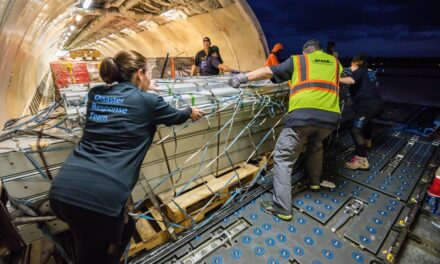
DHL picks Ohio for hub
Kentucky International Airport.
The $200 million DHL facility at the Cincinnati airport will become a "back-up hub," with its current 1,200 job workforce being reduced through attrition to a 300-worker force by fall 2005, Jonathan Baker, DHL director of corporate communications said today.
"That facility is going to be used for the foreseeable future as a backup air hub and sort facility. So we are not closing down CVG," Baker said. "We currently employ about 1,200 people. About 400 of those are full-time positions and about 800 are part-time positions. We do not anticipate that this announcement is going to lead to involuntary severance," Baker said, citing the 40 percent attrition rate in the sort center staff. at the Cincinnati airport.
Employees were notified in two groups Thursday, Baker said, with one more group scheduled for a meeting this afternoon.
"It was a difficult decision, but ultimately it is a decision that will make us a stronger competitive player. That was the principal reason for the choice of Wilmington as a primary hub. It was the optimal decision for both us and our customers," Baker said, declining to comment on the incentive packages offered by either Ohio or Kentucky.
"The decision considered the company's needs for the next 20 to 30 years. Other considerations were available space to house a consolidated air operation and capacity for growth."
The decision is part of a comprehensive $1.2 billion investment in U.S. operations unveiled today. DHL will add seven new regional sort centers and consolidate the two air hubs.
The company called the two states' governors to notify them.
"Steve White from DHL called Gov. Fletcher this afternoon and informed him of DHL's decision to move the hub to Wilmington," Fletcher spokesman Doug Hogan said Thursday night, after talking to the governor, who is vacationing in Florida.
"For now the jobs will stay in Northern Kentucky. We're not sure of the timetable yet," Hogan said, when asked if the Hebron facility would continue operating or if jobs would be lost.
DHL informed Cincinnati/Northern Kentucky Airport Thursday that the main hub will go to Wilmington, said Ted Bushelman, Cincinnati/ Northern Kentucky Airport spokesman.
"They're keeping the building. It's their intention to use it as a back-up hub. They're a corporation. They made a business decision. We of course are very disappointed that they are moving, but we understand it's a business decision."
"And we feel better about the fact that they are keeping it open. They'll still be here for another 18 months," said airport spokesman Ted Bushelman today. Workers leaving the DHL facility at the airport in Hebron about 11 p.m. Thursday said they had been instructed not to talk about the situation.
But Randy Pommier, who works for Astar Cargo, the airline that serves DHL at the airport, said he was not happy at the prospect of jobs being eliminated or heading north.
"Even the ramp people — you are taking away a lot of jobs," said the 45-year-old Florence resident, who does jet maintenance for Astar. He said he would commute to Wilmington if that's what it took to hold on to his job.
Pommier said he was not surprised at DHL's decision. "It's about money and our job is to make them money," he said.
Danny Fore, president of Northern Kentucky Tri-Ed, said he had received no official word from DHL on its decision Thursday night. He declined to speculate on the company's reasoning before talking to officials.
Boone County Judge-Executive Gary Moore said Thursday night that he didn't know anything about the company's plans or reasons for the decision.
But Frankfort officials close to the negotiations gave a clearer picture: "They basically owned another airport. I'm sure it weighed heavily in their decision," Hogan said.
Officials with the Ohio Department of Development did not have any information Thursday.
Ohio Gov. Bob Taft and Kentucky's Fletcher — both Republicans — prioritized the competition to the point of getting personally involved in negotiations with DHL executives. Both states assembled tax incentive packages to keep the jobs they already have, and to be in a position to grew by thousands.
"Obviously DHL is very important to Northern Kentucky and we made an aggressive pitch to keep them in Northern Kentucky," said Hogan.
"Since they own the airport there in Wilmington, they could just not afford to locate in Northern Kentucky."
Hogan also cited the "$160 million-a-year cost associated with waiting for the EPA study to be complete" on environmental impact and noise issues.
"It was a bottom-line decision based on cost. And that's the way business is done," Hogan said, noting that he did not know what Ohio had offered DHL in its incentive package.
Kentucky, he said, needs to create a situation that is conducive to keeping and growing businesses. "We want to keep those expansions in Kentucky. This really highlights the importance of upgrading our tax code and making it as competitive as possible," Hogan said.
Fletcher is currently promoting a tax modernization plan that he argues will make it possible for Kentucky to compete better with other states for business.
"We've got world-class facilities at the Northern Kentucky airport and so that would make it attractive to other ventures," Hogan said.
If DHL were to completely shut the hub in Hebron, it would leave behind a $210 million processing facility, upgraded in 2002 with a total of $41 million in Kenton County Airport Board and state of Kentucky assistance. It would also leave an east-west runway expansion that is currently underway at a cost of millions to accommodate DHL's growth.
The stakes were high for both airports.
Wilmington employs more than 6,000 workers, making it the largest employer in a five-county area north of Cincinnati.
DHL acquired Airborne Express last year for $1.05 billion, giving the cargo business two hubs within 50 miles of each other. DHL's parent company is based in Bonn, Germany, with U.S. subsidiaries.
DHL went from a bit player in the U.S. market to No. 3 last year with the Airborne Express acquisition. It is now behind only Federal Express and United Parcel Service.
The Wilmington facility, a former Air Force base, processes more than six times as many packages as Cincinnati/Northern Kentucky, but the Kentucky facility was recently upgraded by DHL. Kentucky's plant was fully automated, while Wilmington's involves a more labor.
The state of Kentucky contributed $17 million and the Kenton County Airport Board contributed about $24 million to help build the cargo apron for the facility.
Some analysts had speculated that Wilmington had the edge in the bidding because DHL owns the airport outright and would not have to pay fees or share airstrips with other planes.
Noise issues also played in Ohio's favor. As a private airport, Wilmington is not subject to the same regulations as public airports like the Hebron location.
Kentucky was working to help DHL with an environmental impact study to look at noise. Airport agreements with the Sisters of Charity order that runs the College of Mount St. Joseph and with Delhi Township stipulate that noise levels from jets above them will not rise above 62 decibels.
Those agreements kept lawsuits from being filed. But, if cargo expansion at the airport created more noise, the sisters, who live in a protected historic landmark and the officials in Delhi could choose to sue.
So, in choosing Wilmington, DHL avoided costly delays in waiting for the EPA study and possible political and legal fallout over noise levels.
Fletcher said earlier this month that the state had worked to expedite an environmental impact study, which includes noise level measures. LaJuana Wilcher, secretary of the Kentucky Environmental and Public Protection Cabinet, met with the Kenton County Airport Board, which oversees operation of the airport. She also met with DHL officials, once in Cincinnati and once in Frankfort.
The Hebron airport had expected a doubling of cargo planes by 2010, under the assumption that DHL would close its hub in Wilmington and shift those flights to Cincinnati/Northern Kentucky. Officials estimated that daily cargo flights would number 240, or 87,600 a year.
As one of the largest privately owned airports in the country, the Wilmington facility has more than enough capacity to compete with Cincinnati/Northern Kentucky Airport.
The Kentucky facility was closer to many businesses that rely on air cargo. Cincinnati/Northern Kentucky Airport officials also argued that having a professional operating staff in place at the airport that was independent of DHL would have allowed the company to focus better on its core business.
Cincinnati/Northern Kentucky International Airport will receive an $18 million federal grant to help pay for the $250 million project to add a north-south runway and extend the east-west runway. The U.S. Department of Transportation recently held a ceremony commemorating the grant, which was prompted in part by DHL's expansion plans.
The airport is building a third north-south runway and extending the sole east-west runway from 10,000 feet to 12,000 feet.
It is currently expanding the east-west runway to accommodate heavier cargo flights.
Text of fax box follows:
The company
DHL offers air express service to 120,000 destinations worldwide.
It has 188 hubs and 238 gateways.
Total employment is 150,000, in about 5,000 offices.
Note from Barry Hansen:
Dal told me he bought Wilmington, OH airport for $870,000. It will now be
>the major hub for DHL in the USA.













